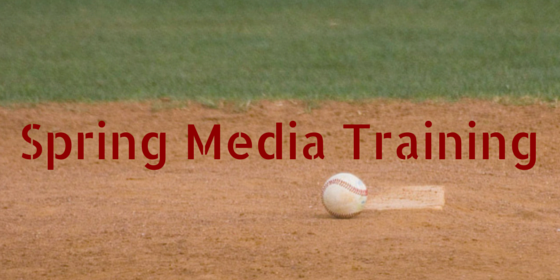Tips from the Dugout: Your Media Interview Windup

Posted By Marian Hughes on March 27, 2015
Start with Smart Scouting
Never go into an interview without doing your homework. Determine the reporter’s beat and if you haven’t already, take the time to read his/her previous articles. Determine if he/she has written about the issue at hand before. And, if so, identify his/her familiarity and depth of understanding on the issue to better prepare for the kind of detail or background they might need to develop a fully-informed story. Take time to familiarize yourself with the publication as well and the focus of its coverage so that you can tailor your remarks to the interests of its readers. This upfront scouting will convey to the reporter that you are informed and interested in helping them to the best of your ability.
Develop Your Game Plan
Based on your scouting and knowledge of what the interview is going to be about, develop a plan for what you would like to accomplish in the interview. Think about the result you’d like to see and the message you’d like to communicate to the reader or viewer. Then make sure you take time to think through your three most important points and how you can deliver those points in the clearest, most succinct and memorable way. Never go into a media interview without having a game plan.
Conduct the Proper Warmup
To help further ensure you are on the same page as the reporter, start the interview by asking them what they’re hoping to learn from the interview, his/her familiarity with the industry and perspective for the piece. A quick warm up with the reporter will help you better determine your role and responsibilities in this interview. Try to determine what aspect is of greatest interest to the reporter. (Take care not to overestimate or underestimate a reporter’s knowledge of your company or the subject. Many are juggling multiple beats and stories, so it’s your job to determine what level of detail they need.) And finally, ask the reporter upfront how much time he/she has for the interview before launching into the discussion. You want to make sure you have enough time to convey the most important information before time has run out.
Seek Connection
Each media interview presents an opportunity for you to build and strengthen your relationship with a reporter as a trusted source, so make sure you’re seizing these opportunities to do so. Try to make the meeting as informative as possible, yet informal and interactive. Take an interest in the reporter’s perspective, because these are opportunities to learn from them as well. And make every effort to ensure the reporter understands what you are trying to communicate. Consider using visuals to underscore important points as well as customer anecdotes to help illustrate and drive a point home.
Finally, maintain your sense of humor -- in most cases, not taking yourself too seriously goes a long way toward building trust and establishes you as an approachable resource. At the close of the interview, ask if you have answered all of their questions. Even if they say ‘yes,’ be sure to leave them with one more brief thought that quickly summarizes your most valuable message. After you have thanked them for their time and encouraged them to stay in touch with you, it’s your responsibility to ensure that you follow up on any action items promptly. The interview should never truly be over in your mind; rather, it should be just the start of an ongoing conversation in which you can provide useful information, news and perspective as matters develop.
These tips for fine-tuning your windup will set the stage for a positive interview experience. But what happens when the topic at hand is challenging to discuss? Tune in to our next blog post where we’ll provide counsel on how to engage with the media on even the toughest subjects when you are bound to get a few dreaded curveballs.

Marian Hughes
Marian Hughes is a Co-founder and Managing Partner at Tier One, where she leads the agency's Chicago office. With more than 30 years of agency experience, Marian has helped shape communications programs for innovative technology brands since the 1990s dot-com boom. Her greatest love is building and leading agile teams that delight clients with creative programming and breakthrough results. When she is not working, Marian enjoys nature and the outdoors — whether through hiking, gardening, or on the pickleball court.


